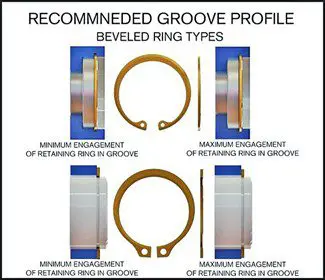Technical Considerations for the Selection of Retaining Rings

BEVELED RINGS FOR RIGID ENDPLAY TAKE-UP
Beveled rings serve essentially the same purpose but they work on a different principle. Advantage is taken of the ring’s spring characteristics, but in the ring’s own plane. The internal ring has a 15 degree bevel along the outer periphery, the external ring along the inner edge. The groove profile corresponds to that of the ring, with the beveled wall bearing the load. Here, too, the calculation of groove location is of utmost importance.
The drawings at left, top and bottom of Figure 7 show minimum groove engagement; that is, with the ring seated to at least half the groove depth. The internal ring is compressed to less than its free diameter, whereas the external ring is spread more than its free diameter. The spring properties of the rings will cause the internal type to open and the external type to close more completely, in each case exerting axial pressure against the retained part. The groove location must be precise to prevent full bottoming of the ring in the groove. The ring acts as a wedge between the groove wall and the part, which it locks rigidly. The assembly will not “breathe” as with a bowed ring that may deflect under load.
While the beveled edge of the ring moves along the beveled groove wall for further endplay take-up, until it may conceivably reach the position shown for maximum groove engagement, it cannot back out, even under load.
It is important to note that bowed rings offer greater endplay take-up than beveled retainers. However, beveled retainers offer rigid endplay take-up and should be considered where cyclic loads occur. (High rotational speeds do not work well with beveled retainers.)
For more help deciding which ring would best fit your application, Contact Us and ask for a Technical Salesman.
More than Parts. A True Partnership.
Our passion is creating the best rings, springs, and clamps. Our mission is to make your work a success. We are here for you.